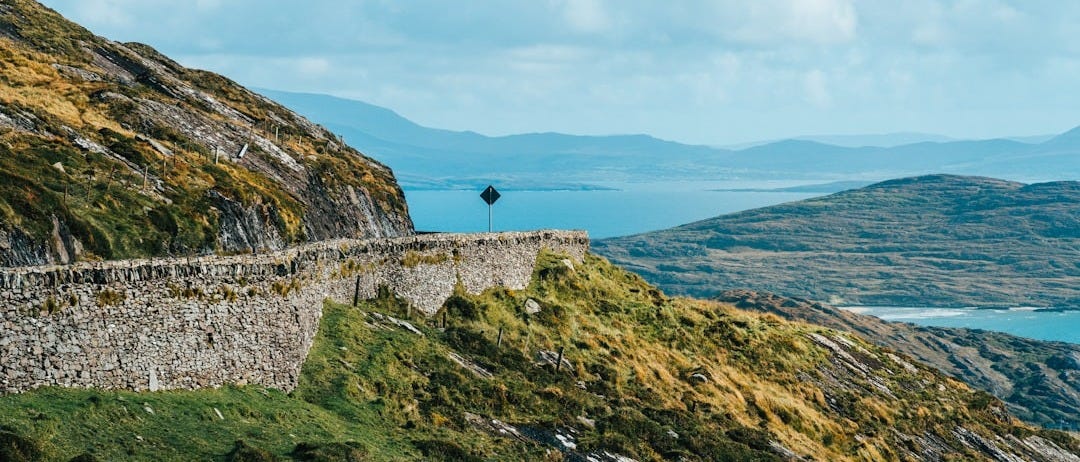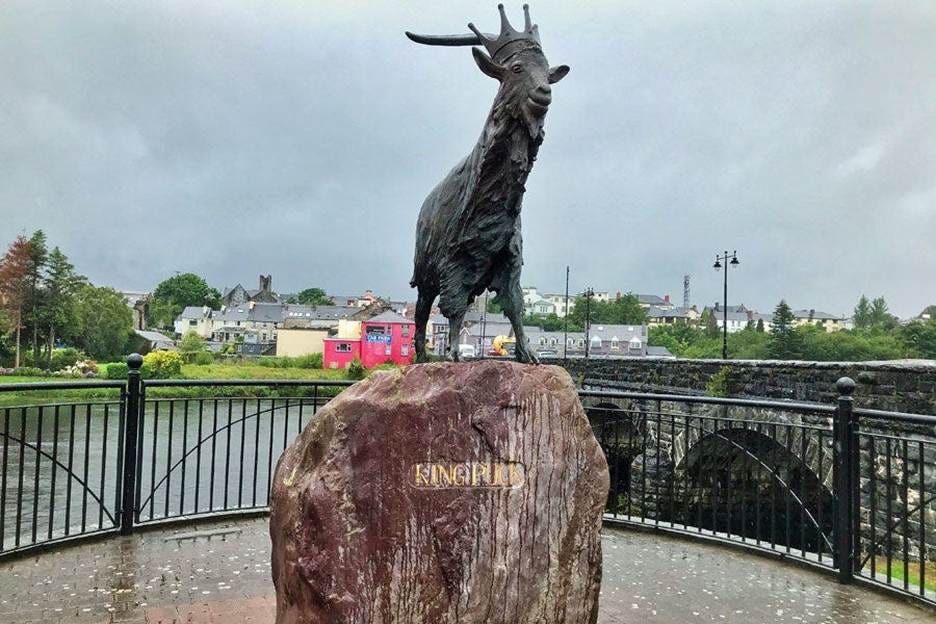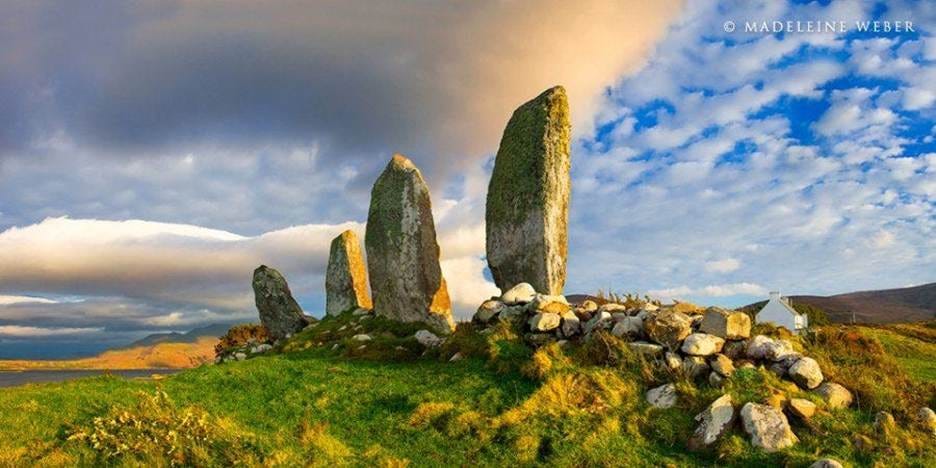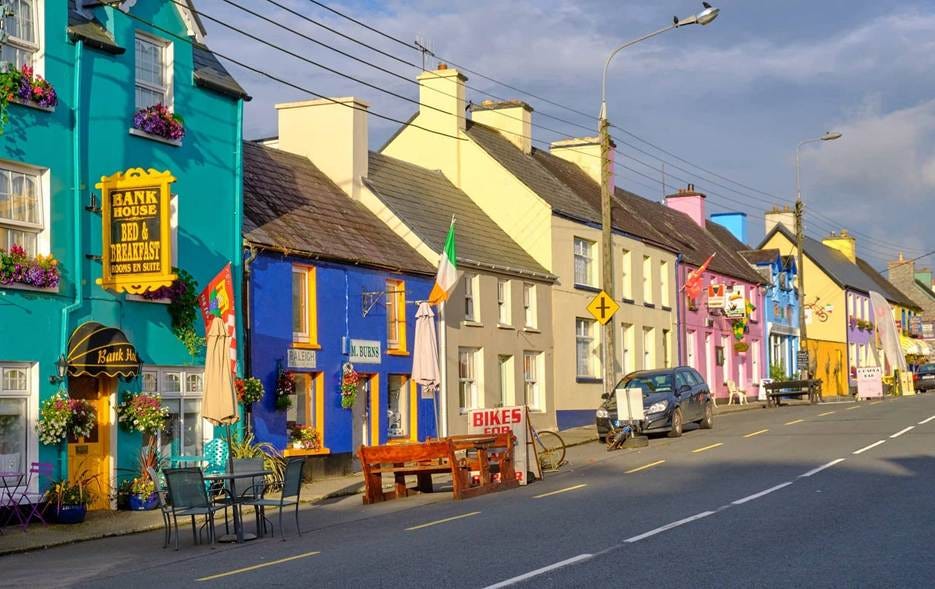The Ring of Kerry: Where the Atlantic Meets Memory
The circular path to belonging

Every time I walk along the promenade in Waterville, I feel a visceral connection to Ireland. Standing at the edge of the Atlantic, with nothing but ocean between myself and Liz and the American life we’ve built, I feel my identity knitting itself together. I know Liz loves this place too, we have explored the ring together, picking out special places and making memories. Even after twenty years of living abroad, this beautiful stretch of Irish coastline still takes my breath away every time I return.
As someone raised in Kildare, where the seaside was a place we went for summer holidays, I never expected this Kerry coastline to become so important to me. Yet now, when I'm in Seattle, thousands of miles from Ireland's shores, this place returns vividly in the quiet moments before sleep—the salt-laden air, the profound feeling of standing at the edge of something vast and eternal, the knowledge that I belong to this place even when my daily life unfolds elsewhere.
The Ring of Kerry, a 100-mile route circling the Iveragh Peninsula in southwest Ireland, has become a pilgrimage. Each trip is like following a spiritual rosary, each landmark an ancient prayer that pulls me deeper into myself. Traditionally beginning in Killarney, this path traces a landscape where mountains plunge into the ocean in displays of natural grandeur, but for me, it maps a geography of belonging that I carry within me across oceans.
Killarney nestles at the edge of its national park, its existence intertwined with the natural beauty at its doorstep. Before tourism transformed this region, before Queen Victoria's 1861 visit cemented it as a destination, this was simply home to generations whose roots go back to earliest times. I see it now through the dual lens of native and foreigner, appreciating it with both the intimacy of home and the perspective distance provides.
As I head out, Carrantouhill rises on my left. It's no Denali, but it's Ireland's highest peak, and seeing its summit emerge from clouds feels like meeting the gaze of an old friend. There's a comfort in these modest mountains that the towering Cascades of my adopted home cannot provide, a sense that the land itself is scaled to human experience.
As the sun climbs higher, I arrive in Killorglin as the town prepares for the day. This ancient settlement holds the distinction of hosting Ireland's oldest fair—Puck Fair—a tradition with pre-Christian roots where a wild mountain goat is crowned "King Puck" each August. The fair began as a market for farm animals, and business is still conducted today. It has evolved into a long weekend of craic and ceol, one I've had the pleasure of recovering from in my younger days. Near the bridge spanning the River Laune stands a bronze statue of King Puck complete with a crown on his head.
I've been away long enough now that Ireland's changes sometimes shock me. New buildings, new roads, new faces. But Puck Fair remains, a reminder that some things don’t change.
The history of this region stretches back millennia. Stone circles and ring forts dot the landscape, silent witnesses to the ancient people of this place. Today's road largely follows paths established by these early inhabitants. Driving along, I think of how I have added my footsteps to this ancient route, even as I've wandered far.
The landscape changes to bog land, with men out engaged in the busy ritual of harvesting turf. I remember stacking turf in the shed at the back of our house at home. An important connection to the land that Irish people have had for generations. The pungent smell of turf on the fire will always transport me to Ireland.
Then, Glenbeigh appears as a picturesque town with flowers and decorations put up by the locals, no doubt for the annual Tidy Towns competition. As we drive by what the locals call Glenbeigh Towers, the ruins of a castellated mansion, I am reminded of the sorrowful history of the place.
The local land agent was vicious in evicting the local people as he extorted rents from them to build the castle for Lord Wynne. The place was hated by locals and destroyed by republican forces during the War of Independence when it was used as a British base.
The countryside's wild beauty reminds me of Kerry's complicated past—how privilege and oppression have always existed side by side here, how the most beautiful places often hide the most painful histories.
As the road winds toward the coast, the landscape unfolds like chapters in an ancient book. The air grows saltier, carrying the scent of seaweed and wildflowers. From an elevated vantage point near the Mountain Stage, the splendor of Dingle Bay stretches before me, with the distant Blasket Islands reminding me of the stories of the legendary Peig Sayers. I always pull over here, knowing the view awaits me like a gift every time.
My next stop is Caitin’s Pub in Kells. I always stop here and wander in for a snack and sometimes something stronger.
I chat with a bartender who knows me well.
“Breakfast ?” he asks, handing me a bag of King crisps, cheese and onion, my favorite.
“Breakfast of champions, make it two” I say.
He laughs. “Are you out chasing faeries?”
“Chasing the ghost of my accent.” I smile.
I step outside, opening the crisps. The smell hits instantly—cheesy and salty—but it carries me across time. The crisps aren’t just a snack; They are keys, unlocking memories I didn’t know I’d buried.
Approaching Cahersiveen, the ruins of Carhan House appear. Once a fine Georgian house, it was the birthplace of Daniel O'Connell, the "Liberator" who championed Catholic emancipation in the 19th century.
In the center of the town is the O'Connell Memorial Church, one of the few Catholic churches in the world that honors a layman. Built of granite and black limestone, the distinctive Neo-Gothic church stands as an architectural anomaly in rural Ireland. The cornerstone is a marble slab sent by the Pope from Rome, where in grisly reciprocity O'Connell's heart is buried.
As Valentia Island comes into view, I'm transported back to childhood weather forecasts on the radio. Valentia, once just a distant name from the far west coast, now materializes before me as I leave the town behind. The sight of the weather station brings back memories of listening to the distinctive voice on the radio as all five of us kids crammed in the back seat coming back from a Sunday drive somewhere.
After exploring Cahersiveen, the road continues along the coast, rising and falling with the dramatic shoreline. Just past the town, road signs shift to Irish, and I enter the Kerry Gaeltacht, a region where Irish is still spoken as a living, everyday language.
In Seattle, my Irishness is sometimes a party trick—an accent, a toast, a story. But here, in the Kerry Gaeltacht, where the road signs shift to Irish, I feel the weight of what I’ve lost.
I am sad to say that my Irish is not as good as I would like, and in some ways, I feel shamed by that. My language has atrophied in America. Language holds culture like a cup. Every word forgotten, feels like a spill I can’t clean up, each word I've lost feels like a wound.
When I discover a Pop-up Gaeltacht event in Seattle, I make a pilgrimage, yearning to practice in real conversation rather than through a screen. Music connects me to language. Sean-nós singing or a slow air on the fiddle creates an invisible bridge across the ocean between my two worlds.
The road curves, new vistas open before me, until I reach Waterville, the village stretched along a perfect crescent of shoreline where the great Atlantic surges against golden sands. This is where I feel most at home and most like a stranger—a paradox of emigrant life.
This is my favorite spot for a morning break. I love walking along the promenade, the smell of the sea washing over me as I take in big gulps of fresh Atlantic air. The scent of salt spray and the rhythmic sound of waves breaking against the shore create a sensory experience that follows me back to Seattle, where the ocean smells a little different, but where the Pacific's rhythms speak the same language.
After my walk, I leave Waterville and I see the Eightercua standing stones, this ancient place is said to be the burial place of Scéine, the wife of Amergin, the leader of the Milesians. The Book of Invasions (Leabhar Gabhála Éireann) tells the story of the arrival of the Milesians, and the death of Scéine.
Amergin was the first of the seven sons of Mil to set foot in Ireland, he was a poet and chanted a magical incantation to the spirit of Ireland, known as The Song of Amergin. The song of Amergin is the earliest voice from the dawn of West European civilization.
I whisper a line of the Song of Amergin to myself, rough and half-remembered.
“I am the wind on the sea…”
For a moment, I believe it. I belong—not just in body, but in lineage, language, and land.
These ancient places in Ireland put me in touch with the sagas and stories that make up where I come from and who I am. I feel a special connection to these most ancient of places in Ireland.
My journey continues through Caherdaniel, where Derrynane House offers a unique window into more modern Irish history as the home of Daniel O'Connell, hailed as the Nelson Mandela of his day. His opposition to slavery and commitment to non-violence, color the lens through which I see the world.
In season, the hedgerows burst with fuchsia, their vibrant colors creating natural bouquets against ancient stone walls. The explosion of blackberries begs me to stop, and I pull over at a pull out where an ould fella is picking berries and filling his basket.
As I pluck a few berries, I savor the fresh flavor in my mouth.
He grins at me like a little boy, “Tá rudaí a phiocann tú féin blaiseadh níos fearr.”
“Tá tú ceart”, I say, juice running down my chin as I smile. Things you pick yourself do taste better.
Just around the next bend lies the charming village of Sneem. It is a perfect arrangement of brightly colored buildings clustered around a two central squares and split by a stone bridge spanning the Sneem River. Its name derives from the Irish "An tSnaidhm," meaning "the knot," aptly describing how the river loops and winds through the village. I love the Irish way of painting houses in this vibrant palette, the burst of color defying the often-gray skies.
This is my regular lunch stop at the Village Kitchen, where the aroma of homemade soups and freshly baked bread greets me even before I open the door. The café is a cheery place with benches outside when the weather is good. I love their fish and chips. In my Northwest home, you can find excellent fish but the chips are better in Ireland. In America they are always trying to make them fancier, I don’t want truffle fries, I want proper chips.
The road climbs toward Moll's Gap, but that is not really a hardship; the increasing elevation reveals ever more spectacular views. I slow down, weaving through the heather-covered mountainsides at the pace of a leisurely stroll. The changing light as clouds pass overhead makes for a new painting every minute. Each turn in the road reveals another vista that catches in my throat.
As the landscape unfolds, I put on some music—traditional tunes, sea shanties, and a touch of bluegrass. Though my modern repertoire remains limited, these melodies weave threads that stretch across the ocean to my life in Seattle, where I listen as I cook, work, or simply sit remembering.
Moll's Gap appears as a natural viewing platform, named for Moll Kissane who ran a small shebeen (illicit pub) here during the construction of the original road in the 1820s. Moll was famous for poitin, and this area is still a hotbed of illegal distilling.
The panorama unveils the full majesty of Macgillycuddy's Reeks, Ireland's highest mountain range. Another perfect picture stop where the changing light surrounds you in timeless beauty.
Ladies View comes next, named after Queen Victoria's ladies-in-waiting who expressed their delight at the vista during the royal visit of 1861. On clear days, the lakes of Killarney sparkle below, their island-dotted expanses commanding attention. The oak woodlands climbing the lower slopes create a tapestry of green that changes hue with each passing hour. I take a photo to send to Liz. I know she’ll recognize it, its one of our places.
Just after Ladies View, as we turn the corner, I see the ruins of Mulgrave Barracks looming like a medieval castle. The blackened walls testify to the destruction wrought by the Royal Irish Constabulary as they retreated into the town during Ireland's War of Independence in the early 1920s. Kerry was a crucible during the War of Independence and in the civil war that followed.
In March 1923, as the Irish Civil War drew to its bitter end, Kerry became the setting for "Terror Month," when anti-treaty attacks and booby traps prompted the Irish Government forces to retaliate by executing seventeen prisoners with explosives at locations like Ballyseedy, Countess Bridge, and Bahaghs.
I think about this darker history as I drive these peaceful roads. The beautiful Kerry countryside, with its mountains, lakes, and coastal vistas, carries these painful memories from that terrible spring. How strange to love a landscape that holds such savagery in its memory, to feel both the pull of belonging and the push of history's ugliness.
Nearing the end, Muckross House stands as a monument to Victorian prosperity, its gardens reflecting the aspirations of a bygone era. This Tudor mansion, built in the 1840s by the Herbert family, carries the weight of Irish history in its walls. The Herberts nearly bankrupted themselves preparing for Queen Victoria's 1861 visit, their desperate social climbing mirroring Ireland's complex relationship with the British empire.
This estate, once a symbol of Anglo-Irish privilege, became Ireland's first National Park in 1932 when gifted to the new Irish Free State. This transformation, from colonial showpiece to national treasure illustrates the way Ireland has moved forward.
The Ring of Kerry is my medicine wheel, my prayer circle, the path I follow to remember who I am and where I come from, even as I build a life elsewhere. The rosary is complete, I have said all my prayers.
The soul of Ireland draws those of us who have wandered far from home. Home becomes more complicated with every passing year of living abroad. It's no longer a single location or even simply a place. It is where Liz is, it is Ireland, it is on a boat, it is the Pacific Northwest, it is by the sea and in the embrace of my family.
Between my annual visits home, I find myself walking the beaches of Washington, recapturing the smell of the sea most of all—the salt, the damp, the wildness. Sailing has made me appreciate the sea anew, the rhythm of the waves, the cry of gulls wheeling overhead. In quiet moments, suspended between the land and the ocean, I feel perfectly at home in the world.





Great article Made me reminisce of our time together on the Ring of Kerry
Outstanding article about the Ring of Kerry. After reading it, I wish it would have been included on our Tauck trip to Ireland. Keep up the great history lessons and environmental reviews.